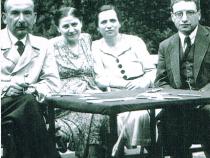Location
Ahrenshooper Zeile 35
District
Schlachtensee
Stone was laid
23 October 2011
Born
28 February 1881 in Berlin
Escape into death
13 October 1942 in Berlin
Richard Lewy-Lingen was born Richard Lewy in 1881. He married Marie Gertrude Fraenkel, a granddaughter of Samuel Strassmann, one of the four Strassmann doctors who moved from Poland to Berlin to continue their medical training. Marie was baptized a Protestant. Richard was of the Mosaic faith.
The couple’s first child, a son, was born in 1920. Richard then extended the family name to Lewy-Lingen, believing it would offer some protection against anti-Semitism. One year later their daughter was born.
Richard Lewy-Lingen was a doctor of law who rose to become a regional court director. Listed in the Berlin directory as retired from 1937 onwards, he was presumably ousted from office in 1936, when he was 55. The date is probably an indication that he had served at the front in the First World War, as President Hindenburg had insisted on the privilege of later dismissal for former frontline soldiers (others were already dismissed in 1934). However, the Nuremberg Laws brought an end to this temporary protection. In the 1930s, the Lewy-Lingen family lived at Nussbaumallee 1 in Berlin-Charlottenburg.
When the Nazis assumed power, it was clear to Dr Richard Lewy-Lingen that the name alone would not protect his family. He and his wife then had their children baptized Protestants. It is not known whether Richard also converted, but he soon realized that his family had no future in Germany. In January or February 1939, the Lewy-Lingens sent their two children to live in England. Richard and Marie moved in with one of Marie’s cousins, Dr Reinhold Strassmann, at Ahrenshooperzeile 35 in Schlachtensee, in September 1939. An apartment here had become available due to the previous tenant’s emigration. Richard and Marie Lewy-Lingen had also applied to emigrate and hoped to be able to join their children soon.
But from 19 September 1941, persons defined as Jewish were prohibited from travelling abroad. The house at Ahrenshooperzeile 35 was forcibly sold at the end of the year, and Richard and Marie Lewy-Lingen had to move into the area around Bayerischer Platz. Classified as “non-Aryan”, they were also made to perform forced labour. It is not known whether Dr Lewy-Lingen was forced to clear bombs or manufacture munitions.
Dr Lewy-Lingen was an astute lawyer, who looked ahead at the immediate future not only with realism but also with pessimism. He soon became aware of what the transports starting in October 1941 really meant. Nobody came back. Not even any sign of life came back from those transported to the east rather than Theresienstadt.
On 13 October 1942, Dr Richard Lewy-Lingen and his wife ended their own lives. Relatives who had managed to emigrate to the United States have described this as an act of self-determination and a way of preserving their dignity.
The couple’s first child, a son, was born in 1920. Richard then extended the family name to Lewy-Lingen, believing it would offer some protection against anti-Semitism. One year later their daughter was born.
Richard Lewy-Lingen was a doctor of law who rose to become a regional court director. Listed in the Berlin directory as retired from 1937 onwards, he was presumably ousted from office in 1936, when he was 55. The date is probably an indication that he had served at the front in the First World War, as President Hindenburg had insisted on the privilege of later dismissal for former frontline soldiers (others were already dismissed in 1934). However, the Nuremberg Laws brought an end to this temporary protection. In the 1930s, the Lewy-Lingen family lived at Nussbaumallee 1 in Berlin-Charlottenburg.
When the Nazis assumed power, it was clear to Dr Richard Lewy-Lingen that the name alone would not protect his family. He and his wife then had their children baptized Protestants. It is not known whether Richard also converted, but he soon realized that his family had no future in Germany. In January or February 1939, the Lewy-Lingens sent their two children to live in England. Richard and Marie moved in with one of Marie’s cousins, Dr Reinhold Strassmann, at Ahrenshooperzeile 35 in Schlachtensee, in September 1939. An apartment here had become available due to the previous tenant’s emigration. Richard and Marie Lewy-Lingen had also applied to emigrate and hoped to be able to join their children soon.
But from 19 September 1941, persons defined as Jewish were prohibited from travelling abroad. The house at Ahrenshooperzeile 35 was forcibly sold at the end of the year, and Richard and Marie Lewy-Lingen had to move into the area around Bayerischer Platz. Classified as “non-Aryan”, they were also made to perform forced labour. It is not known whether Dr Lewy-Lingen was forced to clear bombs or manufacture munitions.
Dr Lewy-Lingen was an astute lawyer, who looked ahead at the immediate future not only with realism but also with pessimism. He soon became aware of what the transports starting in October 1941 really meant. Nobody came back. Not even any sign of life came back from those transported to the east rather than Theresienstadt.
On 13 October 1942, Dr Richard Lewy-Lingen and his wife ended their own lives. Relatives who had managed to emigrate to the United States have described this as an act of self-determination and a way of preserving their dignity.






